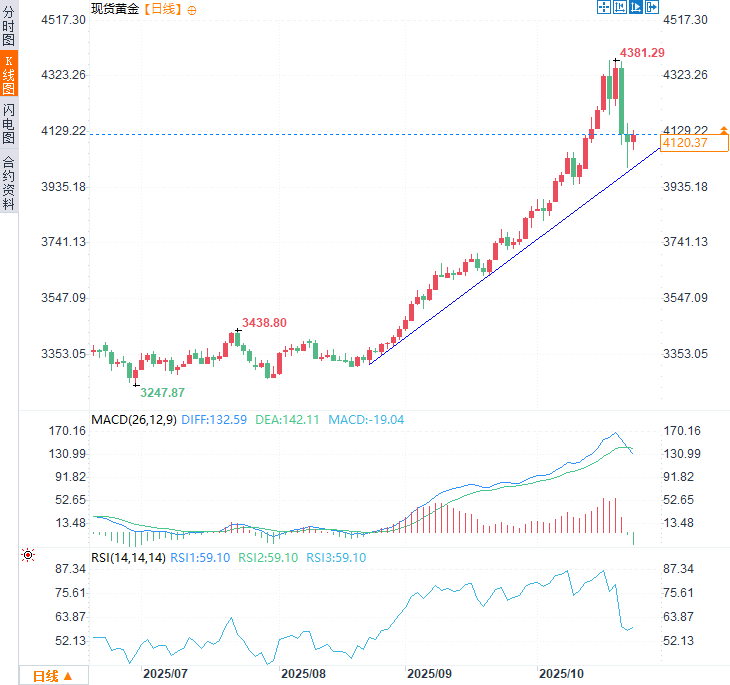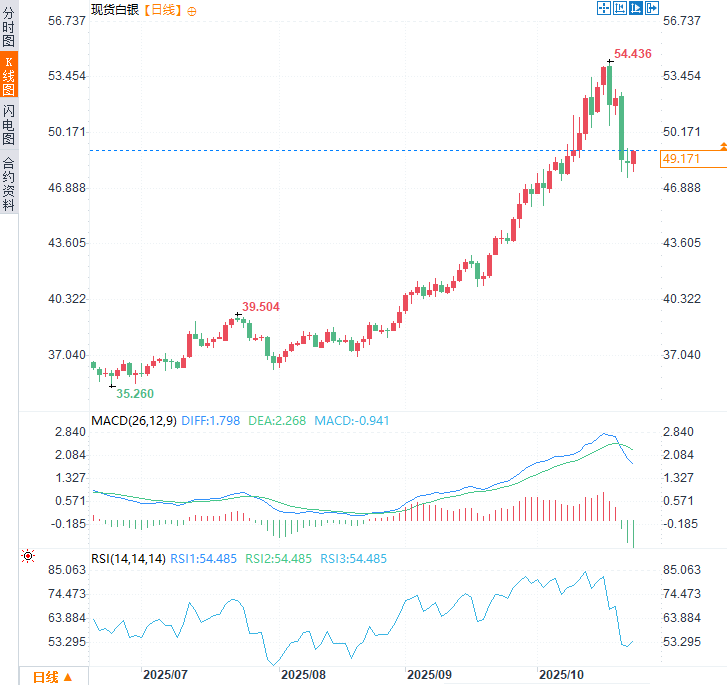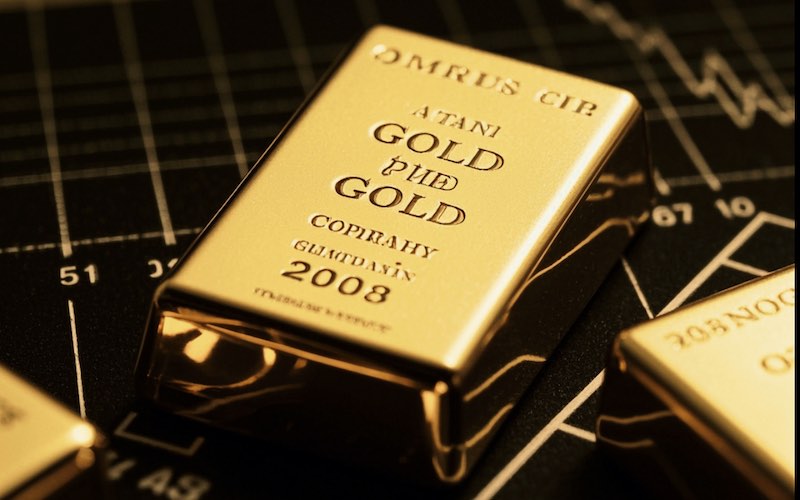Gold and silver bulls strike back, experts warn: Bigger storms lie ahead
2025-10-23 15:05:02
Gold and silver prices tumbled on Tuesday, posting their biggest daily declines in five and four years, respectively, but despite the short-term volatility, conditions leading to overheated markets remain, according to one market analyst.
The ongoing U.S. government shutdown and geopolitical tensions are supporting gold and silver prices, with the market viewing these precious metals as safe-haven assets during times of uncertainty. Expectations of further interest rate cuts from the Federal Reserve are also supporting precious metals prices.

Overbought pressure eased after the plunge in gold and silver, but the allocation ratio is still insufficient
According to Ole Hansen, head of commodity strategy at Saxo Bank, gold and silver prices are undergoing a long-overdue correction, with silver's sharper drop highlighting the liquidity gap between the two metals, but their proportion in investment portfolios remains low and the structural factors driving the rally remain intact.
"While exceptionally strong demand ahead of the (Indian) Diwali festival has supported gold prices, the risk of a pullback has indeed been increasing in recent days," Hansen said Thursday. "However, the combination of a severely overbought technical rally, renewed risk appetite in equities, a stronger dollar, and typically weaker physical demand in Asia following the Diwali festival, has led traders to become more cautious, preferring to lock in profits rather than chase higher prices."
He pointed out that although the specific trigger of Tuesday's sharp sell-off is still unclear, the three unsuccessful attempts of gold prices to attack $4,380 "may prompt precious metals traders to shift their mentality from greed to fear."
Hansen analyzed, "A classic bull-killing-bull scenario ensued: leveraged traders focused on technical analysis liquidated their positions en masse, and new buyers panic-sold after discovering their holdings had fallen below their cost price, instantly squeezing out the narrow exit. The latest market action once again demonstrates the significant difference in liquidity between gold and silver—silver's liquidity is only about one-ninth of gold's. This difference can amplify both gains and losses: a surge in buying quickly depletes limited supply, while any profit-taking can trigger disproportionate fluctuations."
He noted that both gold and silver rebounded on Wednesday after a plunge rarely seen in years. "This sharp pullback suggests that after nine consecutive weeks of surges (gold up 31% and silver up 45%), the market's unilateral bullish sentiment has led to a technical correction in prices ," Hansen said. "As mentioned earlier, in addition to the strengthening US dollar, the main catalyst was weakening demand after Diwali in India. Meanwhile, silver rebounded from support at $47.80, while gold found buying support above $4,000."

(Spot gold daily chart, source: Yihuitong)
He added that the precious metals market was in dire need of a correction to avoid a bubble that could burst more violently in the future.
Hansen noted: “The silver market’s focus has now shifted to the US’s upcoming Section 232 investigation into imports of critical minerals, including silver, platinum, and palladium – a ruling that could reshape short-term supply chains and pricing dynamics on both sides of the Atlantic. A zero tariff ruling would encourage more silver from US inventories to flow to Europe, easing supply tightness in the London market, narrowing the London-COMEX premium, which had reached pandemic-era extremes, and normalizing one-month lease rates.”
Of course, imposing tariffs would have the exact opposite effect. He analyzed, "Silver already in the US would become semi-stranded, exacerbating scarcity in the London market and pushing COMEX premiums even higher. In this scenario, silver could quickly retest—or even break—its recent highs, driven by a renewed squeeze rather than genuine demand growth."
Hansen said Saxo Bank still maintains its bullish forecast for gold and silver prices until 2026 .
He predicts: "After this much-needed correction/consolidation, traders may wait and see until they determine that the core drivers of this year's historic rally have not disappeared. These factors will continue to provide support for precious metals - after all, the current market has removed overbought pressures, but portfolio allocations remain undervalued. In the short term, if a meeting on trade frictions takes place, it will become a key risk event that determines the current correction cycle."
Silver faces a sharp sell-off, but supply shortages point to higher prices
Robert Minter, director of ETF investment strategy at Abrdn, told Kitco News that while Tuesday’s sell-off was sharp, it helped ease overbought conditions in gold and silver.
Minter said if you liked gold and silver last week when prices were unsustainable, you have to like it now because it's in a healthier market. At the same time, Minter said precious metals investors should get used to higher volatility — especially silver, which he expects to continue to experience a severe supply deficit.
Minter noted that the silver market has been in severe supply deficit for the past four years due to growing industrial demand, but it will take some time to clear above-ground inventories. The market has just reached a point where there isn't enough physical metal to meet immediate demand.
Minter said that silver has been in severe supply shortages for years, but no one seemed to care. However, we can see that prices have just begun to consolidate at the beginning of this year.
Minter said, "We shouldn't be surprised to see a rapid revaluation of silver due to market conditions. We also shouldn't be surprised to see some investors taking profits at these levels." Silver prices have seen wild swings this year as markets have come under significant pressure due to the global trade war and the threat of U.S. tariffs.
A surge of silver entered the U.S. at the start of the year, as market participants and bullion dealers stockpiled the precious metal to avoid potential tariffs.
These stocks have hurt the physical market in London, while unprecedented investment demand in recent weeks has completely depleted available inventory—pushing lease rates to record highs and driving up the premium between spot and futures prices. Minter said he doesn't expect market volatility to subside anytime soon. Right now, he said, there's not enough metal to satisfy all the different markets. But he doesn't know what will change that. He doesn't believe there will be enough recycled material to meet demand.
Minter noted that silver mine supply has fallen 8.8% since 2016, despite increased demand. He said the question is, "How are we going to achieve a significant increase in silver supply?" It will require higher prices, but it's also much more than that. He believes no silver miner wants to increase production, but they are constrained. It takes at least 10 years for a new mine to come online. All in all, Minter said, the silver market isn't going to be fundamentally resolved anytime soon.

(Spot silver daily chart, source: Yihuitong)
Gold and silver prices are experiencing a long-overdue correction, with silver’s sharper decline highlighting the liquidity differences between the two - but Ole Hansen, head of commodity strategy at Saxo Bank, points out that both assets are still under-allocated in portfolios and the structural drivers of the rally remain solid.
At 15:04 Beijing time, spot gold was trading at $4118.92 per ounce.
- Risk Warning and Disclaimer
- The market involves risk, and trading may not be suitable for all investors. This article is for reference only and does not constitute personal investment advice, nor does it take into account certain users’ specific investment objectives, financial situation, or other needs. Any investment decisions made based on this information are at your own risk.





















